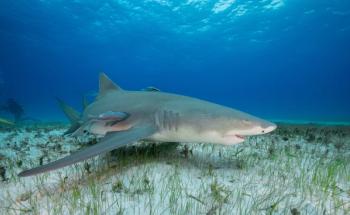
Renal ultrasonography: kidneys big, small, and in-between (Proceedings)
Clipping the hair over the last 2-3 intercostal spaces and extending the area dorsally is important for complete visualization of the right kidney in the dog.
General considerations
Clipping the hair over the last 2-3 intercostal spaces and extending the area dorsally is important for complete visualization of the right kidney in the dog. The left kidney in a dog and both kidneys in a cat are located caudal to the rib cage and are generally easily identified with the animal in dorsal recumbency (lateral recumbency can also be used). A transducer with a small footprint may be necessary for intercostal imaging, while a linear or curvilinear can be used for subcostal imaging. Generally a 5-10 MHz transducer is adequate for most dogs. Higher frequency may be used for cats and small dogs for best image resolution. Scanning the kidneys completely in the longitudinal and transverse plane is important so lesions are not missed.
Ultrasound of the normal kidney
Overall kidney size in a dog can be assessed on ventrodorsal radiographs in comparison to the L2 vertebral body length (normal 2.5-3.5 times the length of L2). Because of the variable size of dogs a method using kidney length to aortic diameter may be used. The ratio of the length of the kidney compared to the aortic diameter at the level of the kidney (K/Ao ratio) is considered normal between 5.5 and 9.1. Normal measurements for the cat kidney range from 3-4.3 cm in length.
The kidneys should be symmetrical in size and shape (oval to bean-shaped).
Margins of the kidney should be smooth and there should be good corticomedullary definition. The renal cortex is more echogenic than the medulla. The renal cortex is less echoic than the spleen and similar to the liver in a dog. In cats the renal cortex can be more hyperechoic (similar to the spleen and greater than the liver). Linear echoic lines (interlobar vessels and diverticuli) divide the medulla to give it a lobulated appearance. At the corticomedullary junction the arcuate arteries may be seen as short, paired, hyperechoic lines.
The renal arteries and veins can be followed to the aorta and caudal vena cava, respectively. The renal pelvis can sometimes be seen in the normal animal measuring less than 2 mm. The ureter should not be seen in the normal animal. The renal sinus surrounding the pelvis contains fat, which gives it a hyperechoic appearance.
Ultrasound of big kidneys
Renomegaly can have numerous causes, many of which can be determined with ultrasound.
Neoplasia may be focal or diffuse. Focal lesions in dogs and cats may vary in echogenicity and would most commonly include renal carcinoma and lymphoma. Lymphoma often results in bilateral diffuse disease, particularly in cats. Multifocal nodules can also be seen with lymphoma. A hypoechoic rim of tissue at the periphery of the cortex is also commonly seen with lymphoma. Depending on the location of the disease there may or may not be changes to the margin.
Renal cysts are characterized by their round to oval shape. Cysts have anechoic contents, a thin wall, and exhibit distal acoustic enhancement. Large numbers of renal cysts, such as with polycystic kidney disease in cats, results in bilateral renomegaly with irregular margins. Focal cysts in dogs often are small; therefore, they do not cause enlargement or shape changes. Large cysts can cause enlargement.
Granulomas and abscesses in the kidneys are uncommon, but could cause focal or diffuse enlargement. Granulomatous disease, as with feline infectious peritonitis, commonly results in bilateral renomegaly in cats.
Ultrasound of small kidneys
Chronic renal disease of various etiologies will result in small, irregular kidneys with increased echogenicity and decreased corticomedullary definition. Often renal infarcts, characterized by hyperechoic and wedge-shaped areas in the renal cortex, will be present in chronic disease. Additionally it is not uncommon to see mineralization (nephrocalcinosis or nephroliths). The inciting cause of the disease usually cannot be determined in cases of chronic disease.
Congenital renal dysplasia results in small, irregular kidneys with increased echogenicity and decreased corticomedullary definition. Pylectasia may also be present.
Ultrasound of kidneys of normal size, but with disease
Many disease processes may cause changes in echogenicity without causing detectable differences in size. In cases of acute interstitial or glomerular nephritis or acute tubular nephrois/necrosis the kidneys are increased in echogenicity. In some diseases the cortex will become more echogenic, while the medulla remains normal in echogenicity. This will result in increased corticomedullary definition (ex. Ethylene glycol toxicity). In other diseases the cortex and medulla may both become increased in echogenicity, which results in decreased corticomedullary definition (ex. Leptospirosis).
Additional findings
A hyperechoic band is sometimes visible in the medulla near the corticomedullary junction termed the renal medullary rim sign. This can be seen in both normal and abnormal animals. Pathologies that have been associated with the medullary rim include mineralization, necrosis, congestion, or hemorrhage.
Renal mineralization may occur in the cortex or medulla (nephrocalcinosis) or in the collecting system (nephroliths). Mineralization is characterized by hyperechoic foci with distal acoustic shadowing. If the renal pelvis is not fluid dilated it can be difficult to determine if the mineralization is parenchymal or within the pelvis. Mineralization of the renal diverticuli will appear as echogenic parallel lines in the medulla.
Perinephric fluid can result in increased size of the renal silhouette on radiographs. Ultrasound readily distinguishes renal from perirenal or retroperitoneal disease. Fluid may be variable in echogenicity. Anechoic to hypoechoic fluid may include urine or hemorrhage in the case of trauma. Exudates and acute hemorrhage will be echogenic. Acute pyelonephritis and ureteritis sometimes will result in fluid and increased echogenicity of the surrounding fat. Perinephric fluid may be seen with leptospirosis. Perinephric pseudocysts in cats appear as a fluid accumulation around one or both kidneys between the capsule and cortex.
Pylectasia, dilation of the renal pelvis, can be seen best on a transverse scan plane at the renal hilus. The appearance will be a C-shaped anechoic area at the hilus. The renal diverticuli may also be dilated with fluid. Dilation of the renal diverticuli can be distinguished from the interlobar vessels if Doppler is available. Intravenous fluid therapy can cause very mild distention of the renal pelvis (2-3 mm). Other causes that can range from mild to severe dilation include ectopic ureters, pyelonephritis, and obstruction (calculi, masses, hematoma, stricture, etc). If the pelvis is dilated it is important to try to follow the ureter from the kidney. Doppler is useful for distinguishing ureter from renal vessels. More severe dilation of the collecting system, hydronephrois, is usually secondary to obstruction and will result in variable loss or thinning of the medullary and cortical parenchyma.
Interventional techniques
It is important to remember that renal disease may be present even when the ultrasound is normal. Ultrasound guided fine needle aspiration or biopsy of diffuse renal disease and nodules/masses can be performed. For the aspirates a 22-gauge, 1 to 1 ½ inch needle is used. Biopsy needles used commonly are 16 to 18-gauge with variable throw length. Aspirates are performed with or without sedation dependent on patient compliance, while biopsy is performed under general anesthesia. For diffuse disease in dogs the caudal pole of the left kidney is most easily accessed. Aspirates are generally obtained from the cortical region. Evaluation for hemorrhage should be performed immediately (and if necessary several hours) following the procedure. Small amounts of blood in the urine may be seen post-biopsy.
Newsletter
From exam room tips to practice management insights, get trusted veterinary news delivered straight to your inbox—subscribe to dvm360.






